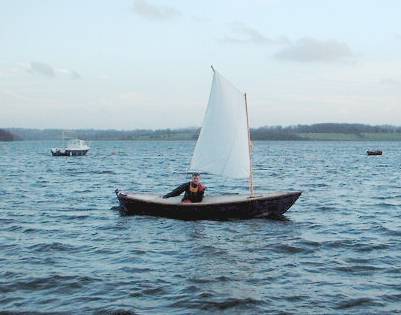Doris the Dory
I'm experiencing a rosy, weary glow after spending
much of the past two days sailing my dory. The boat aside, I
have to say that sailing again in glorious weather has been
great after my long layoff after breaking my collar bone last
summer, and the winter that followed.
Now for the boat. It has been an intense couple
of days, and I've learned some important facts:
- In F5 winds, you need strong rudder fittings
even with a light-weight 16ft boat, and if using a stick to
control a rudder via a yoke, that yoke needs to be quite a lot
wider than the stern of a typical dory - otherwise the force
on the linkage will be surprisingly powerful and can smash whatever
fittings you may be using. Frankly, I think such a yoke needs
to be sufficiently wide to extend significantly beyond the stern,
and in fact beyond scope of any horse used on the mainsheet.
I may decide to go with a more conventional tiller and extension
stick arrangement, not least because that would be more acceptable
to other people who might sail the boat.

- Again in F5 the boat is snug and secure with
50lbs of gravel ballast and a 35sqft sail, but very much underpowered
in an F2 - although I found getting reasonable performance less
of a problem when sailing without the ballast.
- Having tried a large-ish shallow rudder, I will
be reluctant to do so again. It may be that Bolger's inverted-T
is effective, but nothing beats a rudder that goes down a foot
or two so below the boat. JIm and I suspect that a shallow rudder
is hampered by the fact that it is working in
turbulent water.
- Anyone who tells you that no small Banks-style
dory can be successfully made to sail is overstating their case.
Although I doubt this boat will ever frighten the owner of a
racing dinghy, I'm pretty sure it will work well once the problems
I have been having with the rudder have been solved and I have
made a larger sail.
- I have conducted a few tests with the boat filled
with water, and I think that it should be possible to re-enter
and bail the boat, at least with the gravel ballast I've been
using under the thwart - with the large bouyancy tanks built
into each end, the boat wants to pop back up having shed much
of the water inside.

I think that about concludes my experiments with
this boat, as far as using it as a rowing craft are concerned.
The rig isn't right yet, but I'm now sure this is a good looking,
safe and useful rowing dory. For those who haven't followed
my progress, it comes out of 3.5 sheets of 1/4in ply, and is
just under 15ft 4in long, 4ft in beam and about 2ft 8in on the
waterline at 300lbs displacement. It carries bigger loads pretty
well - I've had it with up to 500lbs of people on board.
At these dimensions it seems to row pretty well,
but is more burdensome and less tippy than some existing dory
designs, and I think it's a pretty good compromise. If anyone
fancies building it for rowing and wants some drawings, stay
tuned. Duckworks will soon publish them as free plans for subscribers.
Gavin Atkin

